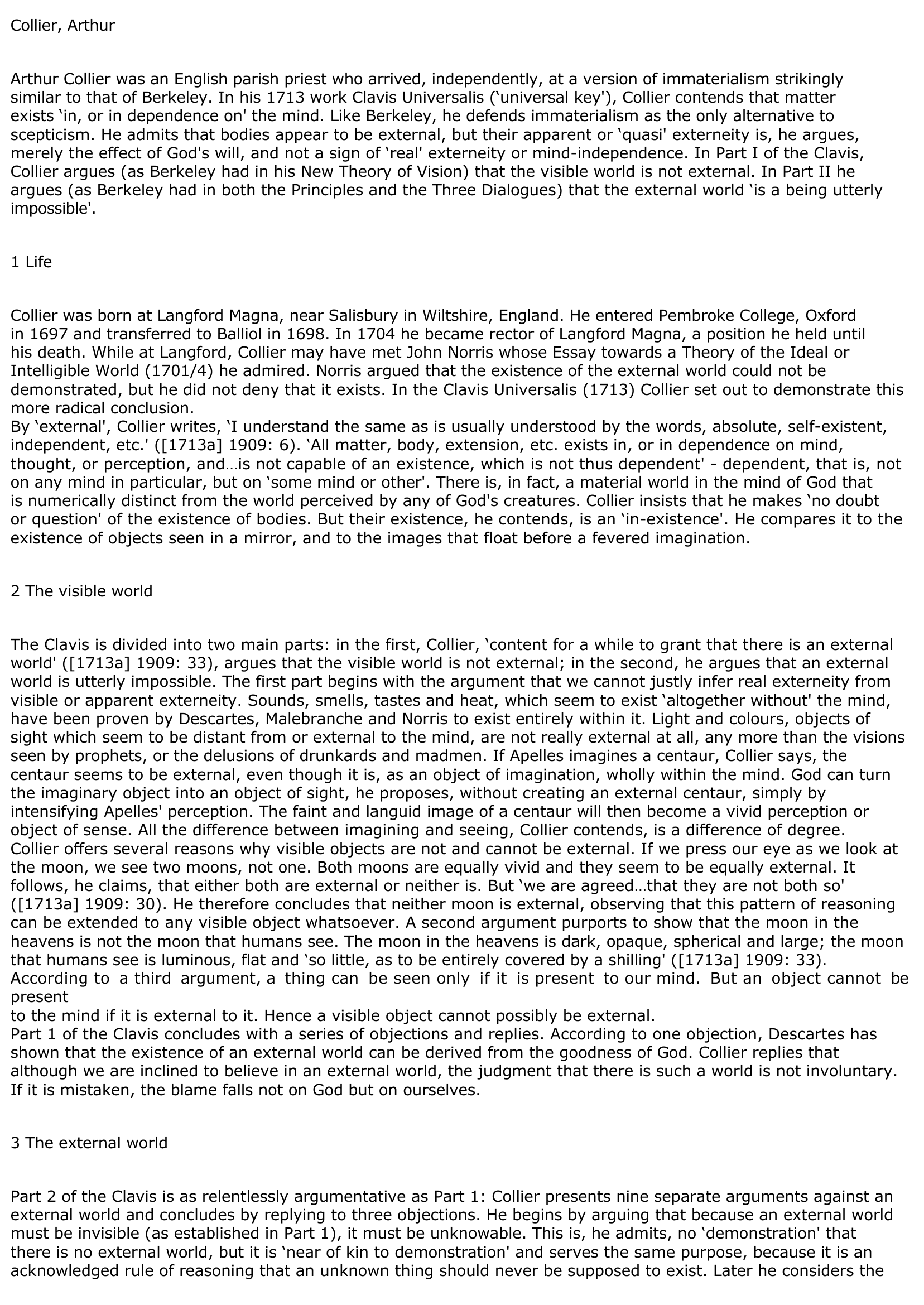Collier, Arthur
Publié le 16/05/2020

Extrait du document
«
Collier, Arthur
Arthur Collier was an English parish priest who arrived, independently, at a version of immaterialism strikinglysimilar to that of Berkeley.
In his 1713 work Clavis Universalis (‘universal key'), Collier contends that matterexists ‘in, or in dependence on' the mind.
Like Berkeley, he defends immaterialism as the only alternative toscepticism.
He admits that bodies appear to be external, but their apparent or ‘quasi' externeity is, he argues,merely the effect of God's will, and not a sign of ‘real' externeity or mind-independence.
In Part I of the Clavis,Collier argues (as Berkeley had in his New Theory of Vision) that the visible world is not external.
In Part II heargues (as Berkeley had in both the Principles and the Three Dialogues) that the external world ‘is a being utterlyimpossible'.
1 Life
Collier was born at Langford Magna, near Salisbury in Wiltshire, England.
He entered Pembroke College, Oxfordin 1697 and transferred to Balliol in 1698.
In 1704 he became rector of Langford Magna, a position he held untilhis death.
While at Langford, Collier may have met John Norris whose Essay towards a Theory of the Ideal orIntelligible World (1701/4) he admired.
Norris argued that the existence of the external world could not bedemonstrated, but he did not deny that it exists.
In the Clavis Universalis (1713) Collier set out to demonstrate thismore radical conclusion.By ‘external', Collier writes, ‘I understand the same as is usually understood by the words, absolute, self-existent,independent, etc.' ([1713a] 1909: 6).
‘All matter, body, extension, etc.
exists in, or in dependence on mind,thought, or perception, and…is not capable of an existence, which is not thus dependent' - dependent, that is, noton any mind in particular, but on ‘some mind or other'.
There is, in fact, a material world in the mind of God thatis numerically distinct from the world perceived by any of God's creatures.
Collier insists that he makes ‘no doubtor question' of the existence of bodies.
But their existence, he contends, is an ‘in-existence'.
He compares it to theexistence of objects seen in a mirror, and to the images that float before a fevered imagination.
2 The visible world
The Clavis is divided into two main parts: in the first, Collier, ‘content for a while to grant that there is an externalworld' ([1713a] 1909: 33), argues that the visible world is not external; in the second, he argues that an externalworld is utterly impossible.
The first part begins with the argument that we cannot justly infer real externeity fromvisible or apparent externeity.
Sounds, smells, tastes and heat, which seem to exist ‘altogether without' the mind,have been proven by Descartes, Malebranche and Norris to exist entirely within it.
Light and colours, objects ofsight which seem to be distant from or external to the mind, are not really external at all, any more than the visionsseen by prophets, or the delusions of drunkards and madmen.
If Apelles imagines a centaur, Collier says, thecentaur seems to be external, even though it is, as an object of imagination, wholly within the mind.
God can turnthe imaginary object into an object of sight, he proposes, without creating an external centaur, simply byintensifying Apelles' perception.
The faint and languid image of a centaur will then become a vivid perception orobject of sense.
All the difference between imagining and seeing, Collier contends, is a difference of degree.Collier offers several reasons why visible objects are not and cannot be external.
If we press our eye as we look atthe moon, we see two moons, not one.
Both moons are equally vivid and they seem to be equally external.
Itfollows, he claims, that either both are external or neither is.
But ‘we are agreed…that they are not both so'([1713a] 1909: 30).
He therefore concludes that neither moon is external, observing that this pattern of reasoningcan be extended to any visible object whatsoever.
A second argument purports to show that the moon in theheavens is not the moon that humans see.
The moon in the heavens is dark, opaque, spherical and large; the moonthat humans see is luminous, flat and ‘so little, as to be entirely covered by a shilling' ([1713a] 1909: 33).According to a third argument, a thing can be seen only if it is present to our mind.
But an object cannot bepresentto the mind if it is external to it.
Hence a visible object cannot possibly be external.Part 1 of the Clavis concludes with a series of objections and replies.
According to one objection, Descartes hasshown that the existence of an external world can be derived from the goodness of God.
Collier replies thatalthough we are inclined to believe in an external world, the judgment that there is such a world is not involuntary.If it is mistaken, the blame falls not on God but on ourselves.
3 The external world
Part 2 of the Clavis is as relentlessly argumentative as Part 1: Collier presents nine separate arguments against anexternal world and concludes by replying to three objections.
He begins by arguing that because an external worldmust be invisible (as established in Part 1), it must be unknowable.
This is, he admits, no ‘demonstration' thatthere is no external world, but it is ‘near of kin to demonstration' and serves the same purpose, because it is anacknowledged rule of reasoning that an unknown thing should never be supposed to exist.
Later he considers the.
»
↓↓↓ APERÇU DU DOCUMENT ↓↓↓
Liens utiles
- Biographie de COLLIER (Arthur).
- Arthur SCHOPENHAUER, Le Monde comme volonté et comme représentation, 181 B, livre IV, trad. A. Burd eau,© PUF, 2e éd. 2004
- Analyse linéaires de Ornière de Arthur Rimbaud
- Commentaire littéraire : « Ma bohème » de Arthur Rimbaud
- analyse linéaire de « Alchimie du verbe » d’Arthur Rimbaud.


